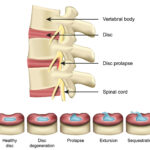The most common reason for spinal surgery is unresolved back pain, neck pain, leg and arm pain, and pain in the hands or feet due to compression of the spine from cervical or other spinal cord issues.
Diseases of the spine, such as spinal stenosis, bulging discs, and sciatica, are also common reasons for an aching back, arms, or legs, and are included among the top reasons a spinal surgeon may recommend spinal surgery.
Four of the most common types of spinal surgery are outlined below. Each of these procedures is a minimally invasive, non-fusion, micro- or endoscopic type of spinal surgery, and all are relatively short operations that allow the patient to leave the surgical facility the same day (outpatient).
1. Microdiscectomy
Treats: Herniated discs, compressed nerves, and pain associated with herniated discs
How it’s Done: The smallest incision necessary and possible is made, and a tiny camera (endoscope) is inserted, to help tiny surgical tools remove part of the herniated disc that is pressing on spinal nerves and causing pain.
Fun Fact: Lumbar herniated discs are the top reason working adults in the United States undergo spinal surgery.
2. Posterior Cervical Microforaminotomy (PCMF)
Treats: Compressed nerves in neck and spine and associated discomfort, arm and hand pain due to cervical disc protrusion.
How it’s Done: Through a minimal incision in the back of the neck, excess scar tissue, bone, and disc material are cleared, and spinal nerve root exits (neural foramen) are enlarged.
Fun Fact: Cervical disc problems are one of the most common types of spinal problems requiring spinal surgery.
3. Laminectomy
Treats: Compressed spine.
How it’s Done: This surgery removes all or part of the thin, bony layer covering the top of the spinal cord (the lamina) to resolve bone spurs in the spine and to relieve pressure on the spinal cord and spinal nerves.
Fun Fact: A lamina can be flattened or arched and forms part of the covering of the spinal cord and spinal nerves.
4. Open Endoscopically Assisted Tubular Retractor Surgery
Treats: Herniated, protruding, extruded, or torn lumbar and cervical discs and associated nerve compression in spine
How it’s Done: A needle, dilator, guidewire, and thin tube are inserted into a vein to open a small 1/4-inch or seven-millimeter portal. In that space, an endoscope is inserted and tiny instruments are used to remove the small portion of the disc compressing the spine.
Fun Fact: Open endoscopically assisted tubular retractor surgery is not technically regarded as surgery; it is simply a small procedure.
Spine surgeons in Portland Oregon
Minimally invasive, outpatient, non-fusion, endoscopic and microscopic spinal surgery types are frequently the more hoped-for spinal surgery types of most neurosurgical patients.
Patients and doctors prefer these types of spinal surgery, when they are an option, over open, inpatient, fusion, and macroscopic types of spinal surgery.
Spinal surgery is more commonplace than ever, so if you need spinal surgery, know that you are one of millions who have undergone the same type of procedure that has been recommended for you.
Today’s spinal surgery types, even when not minimally invasive, are more safe and effective than ever.
If you are experiencing unusual back, neck, arm, or leg pain, especially if this pain radiates to other parts of the body, you may wish to have your doctor refer you to a qualified neurosurgeon like Kuether Brain and Spine, so Dr. Kuether and his team can have you feeling better as soon as possible.










